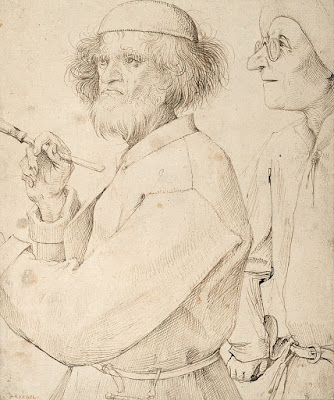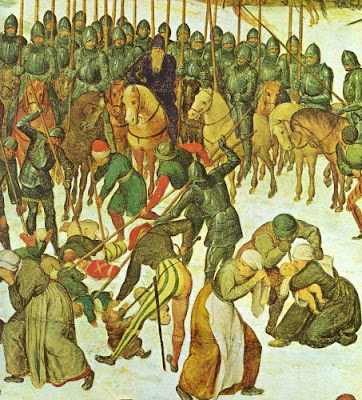This Nativity by Pieter Bruegel the Elder is the second picture I am considering with my pastor friend John Nicholson at
The Shepherd’s Staff. John’s from Alabama, where today they expect a high of 78° F and sun. Here in Rochester we winter under a perpetually gray sky with much snow. The gloom and the oddly trudging figures swathed in black look natural to me but probably seem exotic to John.
My students have spent a lot of time in the past two months talking about composition. They would tell you that it is passing strange to have that Nativity on the edge of the canvas, partially obscured. Many critics have noted this and concluded that this is really a just a Flemish village scene with a Nativity tossed in. I disagree.
Pieter Bruegel’s birth was unrecorded, but it is thought to have been around 1525-30 in either Liège or Brabant. Just as there is ambiguity about his birthplace, there is no record of whether Bruegel died as a Protestant or Catholic. (He was shrewd—he asked his wife to burn his papers after his death.)
Bruegel’s youthful world was wholly Catholic. His training and early career were excellent and orthodox: apprenticeship to a leading Antwerp painter in the Italianate style (Pieter Coecke van Aelst), further studies with an artist-priest (Giulio Clovio) in Rome, a now-lost church altar in 1550-51. The anomaly was Coecke’s wife, Mayken Verhulst, an artist from Mechelin. This city was an early center for peasant genre painting, and she is sometimes credited with transmitting this idea to Bruegel. (She also trained his young sons after his early death in 1569; art history knows her mainly as the root of the Brueghel painting dynasty.)
Bruegel worked with three themes throughout his career: peasants, landscape and religion. In his early work, these converged and diverged in no particular pattern. As a member of a successful atelier family (he married the Coeckes’ daughter) he flourished; he had a high degree of skill as well. But his most brilliant paintings were at the end of his life. Was that simply because he had grown to maturity, or was he responding to the trials of his times?
One of the decrees of the Council of Trent was that religious painting must be suitably elevated; saints must be set apart from mere mortals in dress, demeanor and activity. The Church recognized that saints with dirty feet were a dangerous endorsement of the Protestant concept of a priesthood of all believers.
By then, Reformation was smoldering in the Netherlands; Anabaptists and Calvinists met secretly and illegally. Bruegel left no record of what he thought of this or anything else. But from a Catholic standpoint, his paintings became positively impertinent. Of these paintings, three deserve mention. Bruegel located his Tower of Babel (1563) in a Flemish city and dressed Nimrod as a European king. The Sermon of St. John the Baptist (1566) is militant—subversive, actually—because it clearly depicts a contemporary Calvinist or Anabaptist service. In it he identifies the heretic Protestant preachers with John the Baptist. The Adoration of the Magi of 1564 is a straight-up Nativity scene, but anything but saintly. Notice Mary’s droopy veil, Joseph’s distraction, and the brutish faces of the peasants to his right.
One could ask whether these reflected the views of his patrons or his own religious convictions. I would guess that the two were so intertwined that the question is meaningless. (One of Bruegel’s most important patrons was Cardinal Antoine Perrenot de Granvelle, a leading European statesman and Counterreformer, but if Caravaggio’s experience was an indicator, we shouldn’t read too much into that.)
How powerful art can be! In 1566, the Reformation ignited in the Low Countries. It did so over the issue of art, in the form of the Beeldenstorm (“picture storm”), in which church art was systematically destroyed throughout the Netherlands. Spain responded by sending the cruel Duke of Alba to Brussels (where Bruegel had settled) to extirpate the rebels. This reign of terror—in which thousands died and many more were dislocated—led directly to the Eighty Years’ War.
It was during the height of this terror that Bruegel painted The Adoration of the Magi in the Snow. It’s lovely, but it isn’t peaceful. The central stream of figures is very nearly on the march.
This weekend I uncrated a set of porcelain crèche figures. They are terribly clichéd and indistinguishable from millions of others worldwide. (I treasure them anyway.) Our museums are full of similar Nativities—some brilliant, many not. Some religious art slipped over the line to idolatry, and much was commissioned for base reasons of power and prestige. The
Beeldenstorm set out to destroy the fruits of these bad intentions, but it destroyed indiscriminately. In his last years, Bruegel was feeling his way along the narrow space between the
Beeldenstorm and the Duke of Alba. Today we see his
Adoration as quaint; we don’t remember that it was radical.
The Protestant impulse forced a new way of painting. Artists couldn’t produce idols, so the pattern books of their faith—unchanged for a millennium—were closed to them. How, then, could they articulate their religious feelings? Bruegel actually painted three winter scenes of the Biblical Infancy Narratives. The others are The Slaughter of the Innocents (1565-66) and The Census at Bethlehem (1566).



